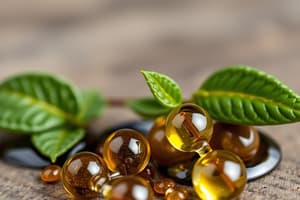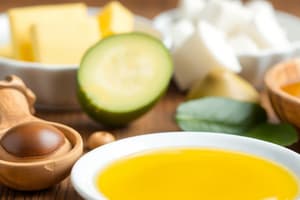Podcast
Questions and Answers
What distinguishes saturated fats from unsaturated fats in terms of their molecular structure?
What distinguishes saturated fats from unsaturated fats in terms of their molecular structure?
- Unsaturated fats are more stable than saturated fats.
- Unsaturated fats contain no double bonds.
- Saturated fats contain multiple double bonds.
- Saturated fats have no double bonds between carbon atoms. (correct)
Which of the following oils is classified as a drying oil?
Which of the following oils is classified as a drying oil?
- Linseed oil (correct)
- Olive oil
- Coconut oil
- Safflower oil
What effect does hydrogenation have on unsaturated fatty acids?
What effect does hydrogenation have on unsaturated fatty acids?
- It creates natural cis bonds.
- It makes them more prone to oxidation.
- It turns them into saturated fats. (correct)
- It decreases their melting point.
Why are trans fats considered harmful to health?
Why are trans fats considered harmful to health?
What is a major benefit of using plant oils for biodiesel fuel production?
What is a major benefit of using plant oils for biodiesel fuel production?
In the fatty acid chain, what is the configuration of hydrogen atoms in cis double bonds?
In the fatty acid chain, what is the configuration of hydrogen atoms in cis double bonds?
Which of the following plant oils is most likely to be solid at room temperature?
Which of the following plant oils is most likely to be solid at room temperature?
What characteristic of trans fats contributes to their stability?
What characteristic of trans fats contributes to their stability?
Which of the following statements about sesame is true?
Which of the following statements about sesame is true?
What is a notable characteristic of cottonseed oil?
What is a notable characteristic of cottonseed oil?
Which of the following is NOT a use of peanut oil?
Which of the following is NOT a use of peanut oil?
From which family does the peanut plant belong?
From which family does the peanut plant belong?
Sesame seeds are known for being high in all of the following nutrients EXCEPT:
Sesame seeds are known for being high in all of the following nutrients EXCEPT:
The main components of the typical Lebanese tahini include all of the following EXCEPT:
The main components of the typical Lebanese tahini include all of the following EXCEPT:
Which factor is primarily responsible for the long shelf life of sesame seeds?
Which factor is primarily responsible for the long shelf life of sesame seeds?
The main oil component of peanuts is primarily composed of:
The main oil component of peanuts is primarily composed of:
What is the primary benefit of using palm oil in food products?
What is the primary benefit of using palm oil in food products?
What is the main use of palm kernel oil?
What is the main use of palm kernel oil?
Which variety of oil palm is known for its high yield?
Which variety of oil palm is known for its high yield?
Which of the following statements is true about coconuts?
Which of the following statements is true about coconuts?
What environmental issue is associated with the expansion of oil palm plantations?
What environmental issue is associated with the expansion of oil palm plantations?
What is the oil content found in both the mesocarp and the seed of the oil palm?
What is the oil content found in both the mesocarp and the seed of the oil palm?
Which product is NOT typically made using palm oil?
Which product is NOT typically made using palm oil?
What is the characteristic color of palm kernel oil?
What is the characteristic color of palm kernel oil?
What is the primary use of flax in its native region?
What is the primary use of flax in its native region?
Which type of flax oil is primarily used for cooking?
Which type of flax oil is primarily used for cooking?
What is the major difference between green and black olives?
What is the major difference between green and black olives?
Which fatty acid is primarily found in olive oil?
Which fatty acid is primarily found in olive oil?
What process must unripe olives undergo to become edible?
What process must unripe olives undergo to become edible?
What climate is optimal for olive tree cultivation?
What climate is optimal for olive tree cultivation?
What percentage of harvested olives is typically used for oil extraction?
What percentage of harvested olives is typically used for oil extraction?
Which variety of sunflower was developed in the 1950s?
Which variety of sunflower was developed in the 1950s?
What is the primary health benefit associated with omega-3 fatty acids?
What is the primary health benefit associated with omega-3 fatty acids?
What is created through the process of saponification?
What is created through the process of saponification?
Which of the following historical records is associated with the earliest mention of soap?
Which of the following historical records is associated with the earliest mention of soap?
Which component of soap molecules is responsible for dissolving non-polar substances?
Which component of soap molecules is responsible for dissolving non-polar substances?
What is the primary process used to produce biodiesel from plant oils?
What is the primary process used to produce biodiesel from plant oils?
Which of the following processes is essential in making historical soaps?
Which of the following processes is essential in making historical soaps?
Which oil is known for producing a mild soap when used in soap making?
Which oil is known for producing a mild soap when used in soap making?
Which plant oil has the highest estimated production yield per hectare?
Which plant oil has the highest estimated production yield per hectare?
What significant drawback is associated with biodiesel in cold weather?
What significant drawback is associated with biodiesel in cold weather?
What is a common modern ingredient in commercial soaps and shampoos that differs from traditional soap ingredients?
What is a common modern ingredient in commercial soaps and shampoos that differs from traditional soap ingredients?
Which of the following acids are canola oil primarily rich in?
Which of the following acids are canola oil primarily rich in?
Which method did Medieval Muslims use to produce the first modern soaps?
Which method did Medieval Muslims use to produce the first modern soaps?
Which statement accurately describes the canola plant?
Which statement accurately describes the canola plant?
What characteristic of sunflower plants contributes to their agricultural viability?
What characteristic of sunflower plants contributes to their agricultural viability?
Which of the following best describes the erucic acid content of canola oil?
Which of the following best describes the erucic acid content of canola oil?
The trans isomer is beneficial for human health.
The trans isomer is beneficial for human health.
Soap is created through the process of esterification of fatty acids with alcohol.
Soap is created through the process of esterification of fatty acids with alcohol.
Olive oil produces a mild soap when used in soap making.
Olive oil produces a mild soap when used in soap making.
The ancient Egyptians are credited with the first modern soaps through saponification.
The ancient Egyptians are credited with the first modern soaps through saponification.
Castile soaps were developed in Spain and Italy using animal fats.
Castile soaps were developed in Spain and Italy using animal fats.
Plant oils are lipid-soluble triglycerides consisting of three fatty acids and ______.
Plant oils are lipid-soluble triglycerides consisting of three fatty acids and ______.
Highly unsaturated plant oils, known as 'drying oils', are used in lubricants, paints, and ______.
Highly unsaturated plant oils, known as 'drying oils', are used in lubricants, paints, and ______.
Hydrogenation is a process that saturates an unsaturated fatty acid chain to prevent ______.
Hydrogenation is a process that saturates an unsaturated fatty acid chain to prevent ______.
Trans double bonds refer to hydrogen atoms being on ______ sides of the double bond.
Trans double bonds refer to hydrogen atoms being on ______ sides of the double bond.
Coconut and palm oils are widely used in processed foods and ______ like shampoos, soaps, and creams.
Coconut and palm oils are widely used in processed foods and ______ like shampoos, soaps, and creams.
Match the following types of fatty acids with their definitions:
Match the following types of fatty acids with their definitions:
Match the following oils with their common characteristics:
Match the following oils with their common characteristics:
Match the following terms with their related effects:
Match the following terms with their related effects:
Match the oils with their typical states at room temperature:
Match the oils with their typical states at room temperature:
Match the following characteristics with the correct oil production aspect:
Match the following characteristics with the correct oil production aspect:
Flashcards
Plant Oils
Plant Oils
Lipids made of three fatty acids and glycerol, extracted from seeds or fruits. They can be liquid (oils) or solid (fats) at room temperature.
Saturated Fats
Saturated Fats
Fatty acids with no double bonds, meaning they're fully saturated with hydrogen atoms.
Unsaturated Fats
Unsaturated Fats
Fatty acids with one or more double bonds, meaning they have some carbon bonds not filled with hydrogen.
Monounsaturated Fats
Monounsaturated Fats
Signup and view all the flashcards
Polyunsaturated Fats
Polyunsaturated Fats
Signup and view all the flashcards
Hydrogenation
Hydrogenation
Signup and view all the flashcards
Trans Fats
Trans Fats
Signup and view all the flashcards
Cis Double Bonds
Cis Double Bonds
Signup and view all the flashcards
Trans Double Bonds
Trans Double Bonds
Signup and view all the flashcards
Trans Isomer
Trans Isomer
Signup and view all the flashcards
Omega-3 Fatty Acids
Omega-3 Fatty Acids
Signup and view all the flashcards
Saponification
Saponification
Signup and view all the flashcards
Hydrophobic
Hydrophobic
Signup and view all the flashcards
Hydrophilic
Hydrophilic
Signup and view all the flashcards
Soap Molecule
Soap Molecule
Signup and view all the flashcards
Castile Soap
Castile Soap
Signup and view all the flashcards
Sodium Laureth Sulfate (SLES) and Sodium Lauryl Sulfate (SLS)
Sodium Laureth Sulfate (SLES) and Sodium Lauryl Sulfate (SLS)
Signup and view all the flashcards
Biodiesel
Biodiesel
Signup and view all the flashcards
Transesterification
Transesterification
Signup and view all the flashcards
Energy Balance
Energy Balance
Signup and view all the flashcards
Canola Oil
Canola Oil
Signup and view all the flashcards
Erucic Acid
Erucic Acid
Signup and view all the flashcards
Polyunsaturated Fatty Acids
Polyunsaturated Fatty Acids
Signup and view all the flashcards
Sunflower Oil
Sunflower Oil
Signup and view all the flashcards
Domestication
Domestication
Signup and view all the flashcards
Sunflower Oil: Key Uses
Sunflower Oil: Key Uses
Signup and view all the flashcards
Flax: Ancient Uses
Flax: Ancient Uses
Signup and view all the flashcards
Flaxseed Oil: Benefits
Flaxseed Oil: Benefits
Signup and view all the flashcards
Olive Tree: Ancient Origins
Olive Tree: Ancient Origins
Signup and view all the flashcards
Olive Oil: Extraction
Olive Oil: Extraction
Signup and view all the flashcards
Olive Oil Quality: Virgin vs. Extra Virgin
Olive Oil Quality: Virgin vs. Extra Virgin
Signup and view all the flashcards
Olive Oil: Benefits
Olive Oil: Benefits
Signup and view all the flashcards
Olive Oil: Uses
Olive Oil: Uses
Signup and view all the flashcards
Sesame (Sesamum indicum)
Sesame (Sesamum indicum)
Signup and view all the flashcards
Sesame Oil
Sesame Oil
Signup and view all the flashcards
Tahini
Tahini
Signup and view all the flashcards
Peanut (Arachis hypogaea)
Peanut (Arachis hypogaea)
Signup and view all the flashcards
Peanut Butter
Peanut Butter
Signup and view all the flashcards
Cottonseed Oil
Cottonseed Oil
Signup and view all the flashcards
Palm Oil
Palm Oil
Signup and view all the flashcards
Palm Kernel Oil
Palm Kernel Oil
Signup and view all the flashcards
Tenera Oil Palm
Tenera Oil Palm
Signup and view all the flashcards
Coconut Copra
Coconut Copra
Signup and view all the flashcards
Coconut Milk
Coconut Milk
Signup and view all the flashcards
Oil Palm Monoculture
Oil Palm Monoculture
Signup and view all the flashcards
Coconut's Tropical Origin
Coconut's Tropical Origin
Signup and view all the flashcards
Hydrophobic & Hydrophilic
Hydrophobic & Hydrophilic
Signup and view all the flashcards
What are plant oils?
What are plant oils?
Signup and view all the flashcards
What are the differences between saturated and unsaturated fats?
What are the differences between saturated and unsaturated fats?
Signup and view all the flashcards
What is hydrogenation?
What is hydrogenation?
Signup and view all the flashcards
What are cis and trans double bonds?
What are cis and trans double bonds?
Signup and view all the flashcards
Why are trans fats unhealthy?
Why are trans fats unhealthy?
Signup and view all the flashcards
Saturated vs. Unsaturated Fats
Saturated vs. Unsaturated Fats
Signup and view all the flashcards
Hydrogenation: What is it?
Hydrogenation: What is it?
Signup and view all the flashcards
Cis vs. Trans Double Bonds
Cis vs. Trans Double Bonds
Signup and view all the flashcards
Study Notes
Plant Oils: Fats, Soaps, & Waxes
- Plant oils are triglycerides, consisting of three fatty acids and glycerol. Oils are liquid at room temp, fats are solid.
- Edible oils include olive, soybean, sunflower, safflower, coconut, palm, canola, sesame, peanut, cottonseed, corn, soybean, and many others. These are widely used in processed foods and cosmetics.
- Saturated fats have no double bonds between carbon atoms in the fatty acid chain, meaning they are saturated with hydrogen atoms.
- Unsaturated fats have one or more double bonds. Monounsaturated have one, polyunsaturated have multiple.
- Hydrogenation saturates unsaturated fats to prevent oxidation and increase viscosity and melting point. However, this creates trans fatty acids, which increase "bad" LDL cholesterol and decrease "good" HDL cholesterol, raising heart disease risk.
- Cis double bonds have hydrogen atoms on the same side of the double bond.
- Trans double bonds have hydrogen atoms on opposite sides of the double bond, making the molecule more stable but not good for human health.
- Trans fats are not naturally present in plant oils but are found in some processed foods.
- Plant oils, especially omega-3 fatty acids, are crucial for human health, for normal child development, and potentially reducing heart disease, depression, and anxiety risks. They may prevent the buildup of abnormal proteins (beta-amyloid and tau).
- Palm oil and palm kernel oil are high in saturated fat, and moderation is key.
- Oil palms are major producers of palm oil and palm kernel oil globally.
Soap
- Soap is a salt of a fatty acid, reacting with a strong base. Historically, soaps were sodium or potassium salts of fatty acids created by hydrolyzing oils. This separates the glycerol from the crude soap.
- Soap molecules have a hydrophobic (water-insoluble) fatty acid end and a hydrophilic (water-soluble) salt end. The hydrophobic end dissolves non-polar substances, like grease and dirt, and the hydrophilic end washes them away with water.
- Earliest soap-like substances date back to the Babylonians and Ancient Egyptians. Ancient Romans created hair pomades by mixing tallow and wood ash. Medieval Muslims created modern soaps from olive oil and thyme. Medieval Europe used animal fat and wood ash for soap.
- Modern soaps and shampoos use detergents like sodium laureth sulfate (SLES), sodium lauryl sulfate (SLS). However, there's a resurgence in natural soaps made from plant oils, such as sodium cocoate, sodium peanutate, saponified olive oil, and others.
- Olive oil soap is used commercially and traditionally.
- Different oils create different types of soap.
Biodiesel Fuel
- Plant oils can be used to produce biodiesel, a renewable fuel consisting of methyl esters.
- Biodiesel is made via transesterification, using alcohol (often ethanol or methanol) to separate fatty acids from glycerol and replace the glycerol with alcohol.
- Biodiesel produces about 60% less net life cycle emissions compared to petrodiesel, but has about 10% higher nitric oxide emissions (an air pollutant) and viscosity issues in cold weather. Production efficiency varies considerably by species. Production can yield over 7,000 kg/ha for some plants such as algae.
- It is a potential substitute for fossil fuels.
Major Plant Oils (Cool Temperatures)
- Canola (Brassica napus): high in healthy oils (omega 3 & 6), used in cooking, salad oils, margarines, mayonnaise, and as a biodiesel source.
- Sunflower (Helianthus annuus): drought-tolerant, used in salad and cooking oils, margarines, and processed foods.
- Flax or Linseed (Linum usitatissimum): high in omega-3 and omega-6 fatty acids, used in cooking oil, and as a mild laxative.
- Corn or Maize (Zea mays): used in cattle feed, biofuel, and as a cooking oil.
- Soybean (Glycine max): used as a cooking oil, in various Asian foods (pastes, sauces), processed foods, and substitutes; high in protein and edible oils.
Major Plant Oils (Warm Temperatures)
- Olive (Olea europaea): native to the Mediterranean, used as cooking and salad oil, and in cosmetics.
- Sesame (Sesamum indicum): ancient use, now used in cooking oils and sauces.
- Peanut (Arachis hypogaea): used in cooking and other processed foods.
- Safflower (Carthamus tinctorius): used in cooking oils and as a dye source.
Major Plant Oils (Tropical Climates)
- Oil Palm (Elaeis guineensis): large, single-stemmed monocot palm, produces palm oil and palm kernel oil used in various food products, soaps, cosmetics and biodiesel. Large plantations in West Africa, Southeast Asia, and South America are major producers.
- Coconut (Cocos nucifera): large fruit containing white fleshy endosperm (coconut meat) or liquid endosperm, used in confections, ice cream, margarines, and other products.
- Tung (Vernicia fordii): High in unsaturated fatty acids, used in paints and varnishes.
Waxes
- Plant waxes are complex lipids, forming protective coatings on leaves—the waxy cuticle layer and some fruits.
- Examples include Carnauba wax (from Carnauba palm), Jojoba wax (from Jojoba shrub), Candelilla wax (from a leafless shrub), and others. Wax production in some species is substantial and can be harvested.
Studying That Suits You
Use AI to generate personalized quizzes and flashcards to suit your learning preferences.




